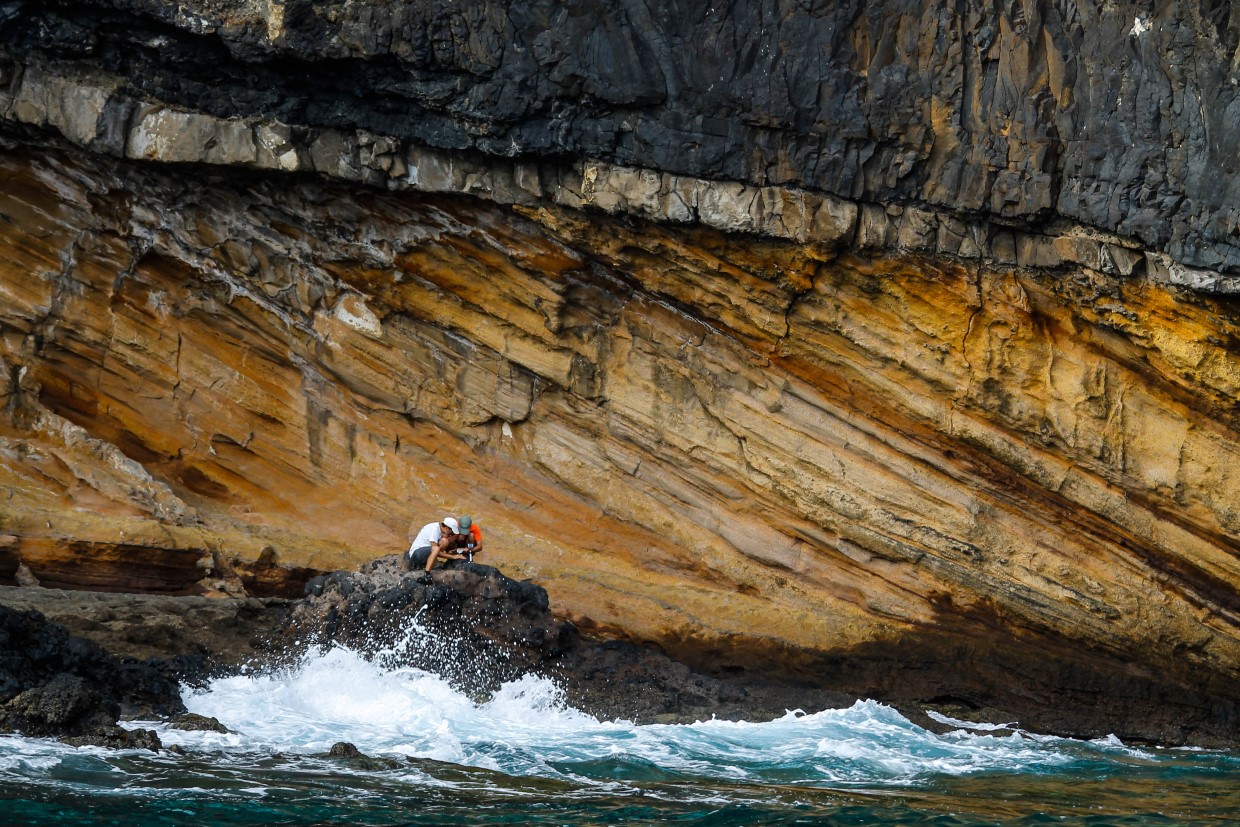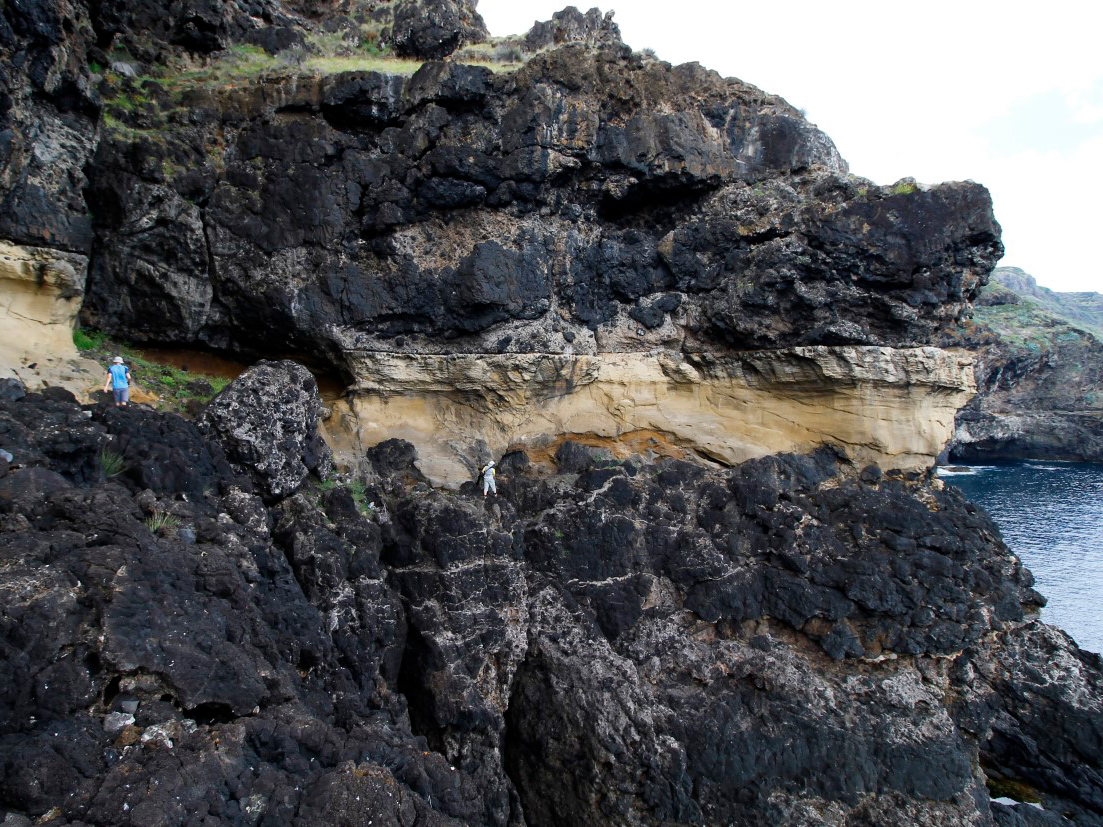Azores
The Azores is the northernmost archipelago of Macaronesia, composed of nine volcanic oceanic islands, their oldest subaerial ages ranging from 6.01 Ma on Santa Maria (Ramalho et al., 2017) to 0.186 Ma for Pico Island (Costa et al., 2015).
The islands are located between latitudes 36°50’ and 39°45’ N and longitudes 31°17’ and 24°56’ W, ~1400 km west of mainland Portugal and ~840 km NW from the Madeira Archipelago. Marine fossiliferous deposits are known only from Santa Maria, the oldest island. Santa Maria is, so far, the only island in the archipelago showing signs of uplift (Ramalho et al., 2017).
The well preserved marine sedimentary sequences were deposited during the Pliocene (Madeira et al., 2011; Ávila et al., 2012, 2018, 2020, 2022; Meireles et al., 2012; Hyzny et al., 2021; Sacchetti et al., 2023) and Pleistocene (Last Interglacial) (Ávila et al., 2009a, 2009b, 2010, 2015a, 2015b), thus providing remarkable information on changes on the geographic distribution of species that took place during those two epochs (cf. Ávila et al., 2015a, 2016; Melo et al., 2022a, 2022b).
Explore the Azores Paleobiodiversity Data
Bibliography
ÁVILA, S.P., P. MADEIRA, C. ZAZO, A. KROH, M. KIRBY, C. MARQUES DA SILVA, M. CACHÃO & A.M. DE FRIAS MARTINS, 2009a. Palaeoecology of the Pleistocene (MIS 5.5) outcrops of Santa Maria Island (Azores) in a complex oceanic tectonic setting. Palaeogeography, Palaeoclimatology, Palaeoecology, 274: 18–31.
ÁVILA, S.P., C. MARQUES DA SILVA, R. Schiebel, F. CECCA, T. backeljau & A. M. DE FRIAS MARTINS, 2009b. How did they get here? The biogeography of the marine molluscs of the Azores. Bulletin of the Geological Society of France, 180: 295–307.
ÁVILA, S.P., A.C. REBELO, A. MEDEIROS, C. MELO, C. GOMES, L. BAGAÇO, P. MADEIRA, P.A. BORGES, P. MONTEIRO, R. CORDEIRO, R. MEIRELES & R. RAMALHO, 2010. Os fósseis de Santa Maria (Açores). 1. A jazida da Prainha, 103 pp. OVGA – Observatório Vulcanológico e Geotérmico dos Açores, Lagoa. ISBN 978-989-8164-09-04.
ÁVILA, S.P., R. RAMALHO & R. VULLO, 2012. Systematics, palaeoecology and palaeobiogeography of the Neogene fossil sharks from the Azores (Northeast Atlantic). Annales de Paléontologie, 98: 167–189.
ÁVILA, S.P., C. MELO, L. SILVA, R. RAMALHO, R. QUARTAU, A. HIPÓLITO, R. CORDEIRO, A.C. REBELO, P. MADEIRA, A. ROVERE, P.J. HEARTY, D. HENRIQUES, C.M. DA SILVA, A.M.F. MARTINS & C. ZAZO, 2015a. A review of the MIS 5e highstand deposits from Santa Maria Island (Azores, NE Atlantic): palaeobiodiversity, palaeoecology and palaeobiogeography. Quaternary Science Reviews, 114: 126–148.
ÁVILA, S.P., R. CORDEIRO, A.R. RODRIGUES, A.C. REBELO, C. MELO, P. MADEIRA & N.D. PYENSON, 2015b. Fossil Mysticeti from the Pleistocene of Santa Maria Island, Azores (NE Atlantic Ocean), and the prevalence of fossil cetaceans on oceanic islands. Palaeontologia Electronica 18.2.27A.
ÁVILA, S.P., C. MELO, B. BERNING, R. CORDEIRO, B. LANDAU & C.M. da SILVA, 2016. Persististrombus coronatus (Mollusca: Strombidae) in the early Pliocene of Santa Maria Island (Azores: NE Atlantic): palaeoecology, palaeoclimatology and palaeobiogeographic implications on the NE Atlantic Molluscan Biogeographical Provinces. Palaeogeography, Palaeoclimatology, Palaeoecology, 441: 912–923.
ÁVILA, S.P., R. RAMALHO, J. HABERMANN & J. TITSCHACK, 2018. The marine fossil record at Santa Maria Island (Azores). In: KUEPPERS, U. & C. BEIER (Eds), Volcanoes of the Azores. Revealing the Geological Secrets of the Central Northern Atlantic Islands. Active Volcanoes of the World. Springer, Berlin, Heidelberg: 155–196.
Ávila, S.P., J.M.N. Azevedo, P. madeira, R. Cordeiro, C.S. Melo, L. Baptista, P. Torres, M.E. JOHNSON & R. vullo, 2020. Pliocene and Late-Pleistocene actinopterygian fishes from Santa Maria Island (Azores: NE Atlantic Ocean): systematics, palaeoecology and palaeobiogeography. Geological Magazine, 157 (9): 1526–1542.
ÁVILA S.P., R.S. Ramalho, C.M. da Silva, M.E. JOHNSON, A. UCHMAN, B. BERNING, R. Quartau, P. Madeira, C.S. Melo, A.c. Rebelo, l. baptista, s. arruda, E. González, M.W. RASSER, a. hipólito, R. Cordeiro, R. MEIRELES, V. RAPOSO, J. POMBO, R. CÂMARA, M.X. KIRBY, J. TITSCHACK, J.M. HABERMANN, r. vullo, A. KROH, j.h. lipps, M. CACHÃO & J. madeira, 2022. Os fósseis de Santa Maria (Açores). 2. Pedra-que-pica: uma história com 5 milhões de anos, 160 pp. OVGA – Observatório Vulcanológico e Geotérmico dos Açores, Lagoa. ISBN 978-989-8164-25-4.
COSTA, A.C.G., A. HILDENBRAND, F.O. MARQUES, A.L.R. SIBRANT & A. SANTOS DE CAMPOS, 2015. Catastrophic flank collapses and slumping in Pico Island during the last 130 kyr (Pico-Faial ridge, Azores Triple Junction). Journal of Volcanology and Geothermal Research, 302: 33–46.
HYZNY, M., C.S. MELO, R.S. RAMALHO, R. CORDEIRO, P. MADEIRA, L. BAPTISTA, A.C. REBELO, C. GÓMEZ, P. TORRES, A. UCHMAN, M.E. JOHNSON, B. BERNING & S.P. ÁVILA, 2021. Pliocene and Late Pleistocene (MIS 5e) decapod crustacean crabs from Santa Maria Island (Azores Archipelago: NE Atlantic): systematics, palaeoecology and palaeobiogeography. Journal of Quaternary Science, 36: 91–109.
MADEIRA, P., A. KROH, R. CORDEIRO, R. MEIRELES & S.P. ÁVILA, 2011. The fossil echinoids of Santa Maria island, Azores (northern Atlantic ocean). Acta Geologica Polonica, 61: 243–264.
MEIRELES, R.P., C. FARANDA, E. GLIOZZI, A. PIMENTEL, V. ZANON & S.P. ÁVILA, 2012. Late Miocene marine ostracods from Santa Maria Island, Azores (NE Atlantic): Systematics, palaeoecology and palaeobiogeography. Révue de Micropaléontologie, 55: 133–148.
MELO, C.S., E. MARTÍN-GONZÁLEZ, C.M. da SILVA, I. GALINDO, A. GONZÁLEZ-RODRÍGUEZ, L. BAPTISTA, A.C. REBELO, P. MADEIRA, A.H.L. VOELKER, M.E. JOHNSON, S.A. ARRUDA & S.P. ÁVILA, 2022. Range expansion of tropical shallow-water marine molluscs in the NE Atlantic during the last interglacial (MIS 5e): Causes, consequences and utility of ecostratigraphic indicators for the Macaronesian archipelagos. Quaternary Science Reviews, 278: 107377.
MELO, C.S., E. MARTÍN-GONZÁLEZ, C.M. da SILVA, I. GALINDO, A. GONZÁLEZ-RODRÍGUEZ, L. BAPTISTA, A.C. REBELO, P. MADEIRA, A.H.L. VOELKER, M.E. JOHNSON, S.A. ARRUDA & S.P. ÁVILA, 2022. Reply to the comment by Meco et al. on “Range expansion of tropical shallow-water marine molluscs in the NE Atlantic during the last interglacial (MIS 5e): Causes, consequences and utility of ecostratigraphic indicators for the Macaronesian archipelagos”. Quaternary Science Reviews, 288: 107535.
RAMALHO, R.S., G. HELFFRICH, J. MADEIRA, M. COSCA, C. THOMAS, R. QUARTAU, A. HIPÓLITO, A. ROVERE, P.J. HEARTY & S.P. ÁVILA, 2017. The emergence and evolution of Santa Maria Island (Azores) – the conundrum of uplifted islands revisited. Bulletin of the Geological Society of America, 129 (3/4): 372–391.
SACCHETTI, C., B. LANDAU & S.P. ÁVILA, 2023. The Lower Pliocene marine gastropods of Santa Maria Island, Azores: Taxonomy and palaeobiogeographic implications. Zootaxa, 5295(1): 1–150.
How to cite:
MPDb (2023). Azores. Macaronesian Palaeobiodiversity Database. https://macpaleo.uac.pt/














